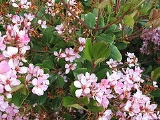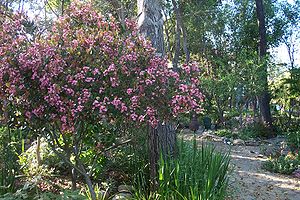
Rhaphiolepis
Encyclopedia
Rhaphiolepis is a genus of about 15 species of evergreen
shrub
s and small tree
s in the family Rosaceae
, native to warm temperate and subtropical eastern and southeastern Asia
, from southern Japan
, southern Korea
and southern China
south to Thailand
and Vietnam
. The genus is closely related to Eriobotrya
(loquat
s). The common name hawthorn (shared with the related genus Crataegus
) is used for the species.
The species vary in size, some only reaching 1-1.5 m, while R. ferruginea can reach 10 m. The leaves
are alternate, leathery, glossy dark green, simple, 3–9 cm long, with an entire or serrated margin. The flower
s are white or pink, 1–2 cm diameter, produced in small to large corymb
s. The fruit
is a small pome
1–2 cm diameter, ripening dark purple to black, usually containing only a single seed
.
 The best known species is R. indica (Indian Hawthorn) from southern China, grown for its decorative pink flower
The best known species is R. indica (Indian Hawthorn) from southern China, grown for its decorative pink flower
s, and popular in bonsai
culture. R. umbellata (Yeddo Hawthorn) from Japan and Korea has blunter leaves and white flowers. It is the hardiest species, tolerating temperatures down to about -15 °C.
The fruit of some varieties is edible when cooked, and can be used to make jam, but some ornamental varieties bear fruit that is of no culinary value.
 Indian Hawthorn is a mainstay horticultural specimen in southern United States. It is often found in commercial as well as in private landscapes. Often it is trimmed into small compact hedges or balls for foundation plants. It has been successfully pruned into a standard form as well as small dwarf-like trees up to 15 feet in height.
Indian Hawthorn is a mainstay horticultural specimen in southern United States. It is often found in commercial as well as in private landscapes. Often it is trimmed into small compact hedges or balls for foundation plants. It has been successfully pruned into a standard form as well as small dwarf-like trees up to 15 feet in height.
The use of Rhaphiolepis in landscapes in humid regions is limited by the susceptibility of many of its species and hybrids to a disfiguring leaf spot
disease caused by fungi in the genus Entomosporium.
Evergreen
In botany, an evergreen plant is a plant that has leaves in all seasons. This contrasts with deciduous plants, which completely lose their foliage during the winter or dry season.There are many different kinds of evergreen plants, both trees and shrubs...
shrub
Shrub
A shrub or bush is distinguished from a tree by its multiple stems and shorter height, usually under 5–6 m tall. A large number of plants may become either shrubs or trees, depending on the growing conditions they experience...
s and small tree
Tree
A tree is a perennial woody plant. It is most often defined as a woody plant that has many secondary branches supported clear of the ground on a single main stem or trunk with clear apical dominance. A minimum height specification at maturity is cited by some authors, varying from 3 m to...
s in the family Rosaceae
Rosaceae
Rosaceae are a medium-sized family of flowering plants, including about 2830 species in 95 genera. The name is derived from the type genus Rosa. Among the largest genera are Alchemilla , Sorbus , Crataegus , Cotoneaster , and Rubus...
, native to warm temperate and subtropical eastern and southeastern Asia
Asia
Asia is the world's largest and most populous continent, located primarily in the eastern and northern hemispheres. It covers 8.7% of the Earth's total surface area and with approximately 3.879 billion people, it hosts 60% of the world's current human population...
, from southern Japan
Japan
Japan is an island nation in East Asia. Located in the Pacific Ocean, it lies to the east of the Sea of Japan, China, North Korea, South Korea and Russia, stretching from the Sea of Okhotsk in the north to the East China Sea and Taiwan in the south...
, southern Korea
Korea
Korea ) is an East Asian geographic region that is currently divided into two separate sovereign states — North Korea and South Korea. Located on the Korean Peninsula, Korea is bordered by the People's Republic of China to the northwest, Russia to the northeast, and is separated from Japan to the...
and southern China
China
Chinese civilization may refer to:* China for more general discussion of the country.* Chinese culture* Greater China, the transnational community of ethnic Chinese.* History of China* Sinosphere, the area historically affected by Chinese culture...
south to Thailand
Thailand
Thailand , officially the Kingdom of Thailand , formerly known as Siam , is a country located at the centre of the Indochina peninsula and Southeast Asia. It is bordered to the north by Burma and Laos, to the east by Laos and Cambodia, to the south by the Gulf of Thailand and Malaysia, and to the...
and Vietnam
Vietnam
Vietnam – sometimes spelled Viet Nam , officially the Socialist Republic of Vietnam – is the easternmost country on the Indochina Peninsula in Southeast Asia. It is bordered by China to the north, Laos to the northwest, Cambodia to the southwest, and the South China Sea –...
. The genus is closely related to Eriobotrya
Eriobotrya
Eriobotrya is a genus of about ten species of large evergreen shrubs and small trees in the family Rosaceae, native to east and southeast Asia.-Species:By far the best known species is the Loquat, E...
(loquat
Loquat
The loquat , Eriobotrya japonica, is a fruit tree in the family Rosaceae, indigenous to southeastern China. It was formerly thought to be closely related to the genus Mespilus, and is still sometimes known as the Japanese medlar...
s). The common name hawthorn (shared with the related genus Crataegus
Crataegus
Crataegus , commonly called hawthorn or thornapple, is a large genus of shrubs and trees in the rose family, Rosaceae, native to temperate regions of the Northern Hemisphere in Europe, Asia and North America. The name hawthorn was originally applied to the species native to northern Europe,...
) is used for the species.
The species vary in size, some only reaching 1-1.5 m, while R. ferruginea can reach 10 m. The leaves
Leaf
A leaf is an organ of a vascular plant, as defined in botanical terms, and in particular in plant morphology. Foliage is a mass noun that refers to leaves as a feature of plants....
are alternate, leathery, glossy dark green, simple, 3–9 cm long, with an entire or serrated margin. The flower
Flower
A flower, sometimes known as a bloom or blossom, is the reproductive structure found in flowering plants . The biological function of a flower is to effect reproduction, usually by providing a mechanism for the union of sperm with eggs...
s are white or pink, 1–2 cm diameter, produced in small to large corymb
Panicle
A panicle is a compound raceme, a loose, much-branched indeterminate inflorescence with pedicellate flowers attached along the secondary branches; in other words, a branched cluster of flowers in which the branches are racemes....
s. The fruit
Fruit
In broad terms, a fruit is a structure of a plant that contains its seeds.The term has different meanings dependent on context. In non-technical usage, such as food preparation, fruit normally means the fleshy seed-associated structures of certain plants that are sweet and edible in the raw state,...
is a small pome
Pome
In botany, a pome is a type of fruit produced by flowering plants in the subfamily Maloideae of the family Rosaceae.A pome is an accessory fruit composed of one or more carpels surrounded by accessory tissue...
1–2 cm diameter, ripening dark purple to black, usually containing only a single seed
Seed
A seed is a small embryonic plant enclosed in a covering called the seed coat, usually with some stored food. It is the product of the ripened ovule of gymnosperm and angiosperm plants which occurs after fertilization and some growth within the mother plant...
.
Cultivation and uses

Flower
A flower, sometimes known as a bloom or blossom, is the reproductive structure found in flowering plants . The biological function of a flower is to effect reproduction, usually by providing a mechanism for the union of sperm with eggs...
s, and popular in bonsai
Bonsai
is a Japanese art form using miniature trees grown in containers. Similar practices exist in other cultures, including the Chinese tradition of penjing from which the art originated, and the miniature living landscapes of Vietnamese hòn non bộ...
culture. R. umbellata (Yeddo Hawthorn) from Japan and Korea has blunter leaves and white flowers. It is the hardiest species, tolerating temperatures down to about -15 °C.
The fruit of some varieties is edible when cooked, and can be used to make jam, but some ornamental varieties bear fruit that is of no culinary value.

The use of Rhaphiolepis in landscapes in humid regions is limited by the susceptibility of many of its species and hybrids to a disfiguring leaf spot
Leaf spot
Leaf spots are round blemishes found on the leaves of many species of plants, mostly caused by parasitic fungi or bacteria.A typical spot is "zonal", meaning it has a definite edge and often has a darker border. When lots of spots are present, they can grow together and become a blight or a blotch...
disease caused by fungi in the genus Entomosporium.

